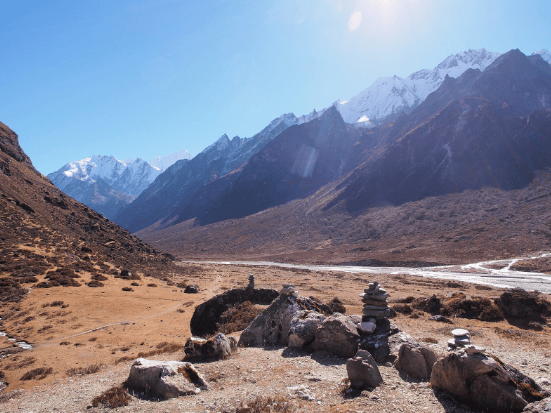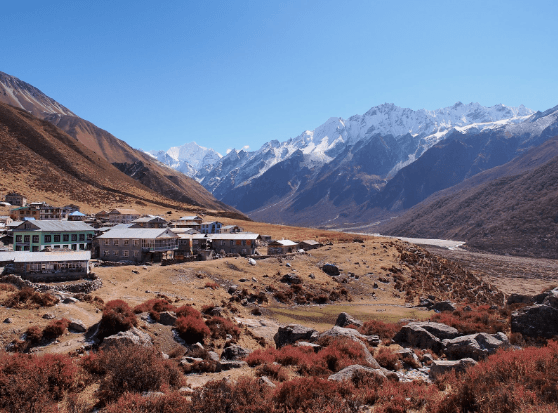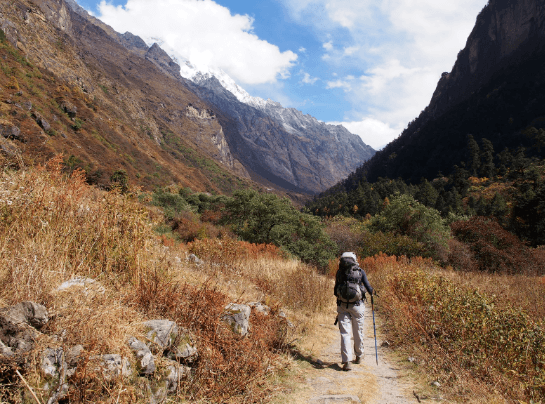Langtang Valley Trek is one of the best routes to explore Nepal’s amalgamation of rich heritage and natural charm.
At a breathtaking elevation of 7,246 meters above sea level, Langtang Lirung is the highest mountain in the region. The beauty of the mountain is a surreal spectacle.
In this trek, you will witness dew-fresh mountains and walk across ancient monasteries that tell the historical tale of the culture and heritage of Northern Nepal.
Vacationing amidst hills and mountains is definitely going to soothe your mind, body, and soul. But, what is so special about Langtang Valley Trek that makes it stand apart from other trek route and snowy regions?
Trust this Complete Guide to Langtang Valley Trek for planning your next heavenly vacation in the Langtang region.
Langtang Valley Trek itinerary
We advise you to stay in Syabrubesi for a day and get acclimatized. You can explore the area and go shopping for trinkets on your first day. There are a few restaurants on the way that offer typical Nepali delicacies.
Also, cultural celebrations pose for beautiful photos and videos throughout the year. Definitely a good place to start vlogging. And don’t forget to check the dates for local festivals as they offer an amazing insight into the local lifestyle.
Basically, this itinerary has been designed in a way that none of the routes see a rapid increase in altitude. In any case, if there are signs of Acute Mountain Sickness (AMS), get to a lower altitude without any delay.
Day 01: Arrival in Kathmandu (1,350m/4,428ft)
Day 02: Kathmandu: sightseeing and trek preparation
Day 03: Drive from Kathmandu to Syabrubesi (1,550m/5,100ft): 7-8 hours
Day 04: Trek from Syabrubesi to Lama Hotel (2,380m/7,830ft): 6 hours
Day 05: Trek to Mundu (3543m/11,621ft) via Langtang village: 6-7 hours
Day 06: Mundu to Kyangjin Gompa (3,870m/12,697ft): 4-5 hours
Day 07: Acclimatization- Explore Tserko Ri (5000m/16,404ft) 7-8 hours
Day 08: Kyangjin Gompa to Lama Hotel: 6-7 hours
Day 09: Lama Hotel to Syabrubesi: 4-5 hours
Day 10: Syabrubesi to Kathmandu
Day 11: Final departure
Trek Permits and Logistics for Langtang Valley Trek
There are 2 obligatory permits required for Langtang Valley Trek.
- The Local Area Permit
- 10 USD per person
- Langtang National Park Permit
- 30 USD per person
Best Time To Trek to Langtang Valley
The most exciting and amiable weather is Autumn which is from September to November. It marks the best time to go on the Langtang Valley Trek. The sight of the rhododendron forest welcomes visitors during this season.
Spring and summer blend extreme hot weather at low levels with high humidity and thunderstorms. You will experience mildly warm temperatures at lower levels, and it gets colder as you go higher. Nevertheless, this is the best season to witness the flowering plants of the region.
During Winter (between December – February), the skies are usually clear with very little rain, which means it is perfect for observing the night skies. However, at higher elevations, the weather can be drastically cold and require proper equipment.
You can visit the region all year-round, nonetheless.
Meals and Accommodations in Langtang Valley Trek
Although the number of lodges and tea houses is swiftly growing, some areas in Langtang Valley Trek still lacks enough housing for travelers. However, you can opt for a camping trek which is gaining more popularity these days. The major differences between these two are listed below:
| Tea-House Trek | Camping Trek |
| Stay in guest houses and hotels | Requires one to stay in a tent |
| All the basic necessities provided | Need to bring your own equipment |
| Comparatively less expensive | Comparatively more expensive |
Trekkers may have to compromise on food quality on this trek. While some trekkers prefer to enjoy local food (mainly Daal Bhat), others may not be satisfied with it for the long journey. You need to carry your own snacks for the day as the availability of such items in the trek is not guaranteed.
Although, there is availability of bottled water in almost all of the teahouses en-route the trek, we recommend not using them to decrease plastic pollutants in the environment. Instead carry your own water bottle and fill it at the teahouses you stay in. Learn how to clean water beforehand so you can ensure the water you drink is clean and safe.
Langtang Valley Trek Difficulty
The trek entails traversing six different climatic zones from sub-tropical to tundra, gaining gradual altitude from 1,460 to 4,733 meters.
Walking into thin air covering 100 over kilometers makes this trek relatively harder than ABC or EBC.
Add-ons on the Langtang Valley Trek
Although must-have items for backpacking in Nepal are similar for most of the treks, Langtang, being one of the challenging treks requires some specifics. We have compiled a list of equipment to make your trip easy and comfortable. We advise you to carry only the necessary items and save your expenses.
- Down Jacket
- Trouser, T-shirts
- Hiking Boot
- Sunglasses
- Sun cream
- Walking Poles
- Head Lamps
- Sleeping Bag
- Liner socks
- Trekking shirts short sleeve
- Thermal underwear
- Lightweight fleece sweaters
- Woolen trekking socks
Also, make sure you choose the right gear and always double test your gears before beginning the trek. A small difference in size may cause huge difficulty in the long treks.
For instance, not being able to complete high altitude trek due to blisters on feet is quite common. So be advised!
Some Tips for Langtang Valley Trek
- Drink enough fluid and always remain hydrated. This is the ultimate protection against Acute Mountain Sickness.
- Always drink purified water and learn how to clean water beforehand.
- Be aware of uncooked food, keep yourself vegetarian unless fresh meat is available.
- Carry some high-calorie snacks like protein bars, raisins, and peanuts.
- Always make sure you pack the right gear for high altitude trek
- Consuming alcohol and smoking increase the possibility of altitude sickness, so avoid it.
- Carry a first aid box with any medications you’re taking. Bring enough meds for the trek and DO NOT use any medicine that you are not sure about.
- Do not sleep during the day at high altitude. It is recommended to move around and keep yourself active.
- It is normal to get a little headache or slight fever while adjusting to the varying altitude. So don’t be too worried about it.
- Make sure you have all the required permits for the trek.
- Some areas in Langtang experience power cuts, meaning you will need a power bank to charge your gadgets.
Conclusion
If you’re passionate about traveling, Langtang Valley Trek is a must-see destination.
It is a wonderful journey and also, it will not break the bank (at least not too much!).
You will appreciate the natural ambiance and rich culture the region has to offer for the rest of your life.
Happy Travelling!
Discover more from Don't Stop Living
Subscribe to get the latest posts to your email.



